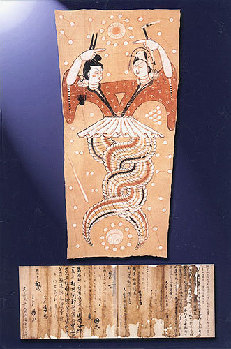Tombs for the nobles inGaochangCity, from the Western Jin to the Tang Dynasty
Location: Turpan,Xinjiang UygurAutonomous Region
Period: mid of 3rd century-end of 8th century AD
Excavated from 1959 to the present
Significance: It has supplied important material objects to the study of the economic, cultural developments ofGaochangCityfrom the Western Jin Dynasty (3rd century AD) to the Tang Dynasty (8th century AD), as well as the changes of folk customs.
 Introduction
Introduction
Astana Ancient Tombs lie in San Pu and Er Pu Xiang 42 kilometers southeast of Turpan city. It had been the public graveyard of ancient Gaochang people with an area of about 10 square kilometers. Since 1959, 456 tombs have been excavated and thousands of cultural relics have been unearthed. Besides hundreds of dried up bodies, there are murals depicting figures, birds and flowers on display in the three tombs. Altogether 2,000 documents were unearthed, with content covering political, economic, cultural and military developments ofGaochangCity.
|

|
| Painting on silk with Fu Xi and Nu Wa, two mythological figures in ancient China: (up, length 184 cm); Document written on paper: (bottom, length 76.5 cm) |
 TheAncientCityof Gaochang
TheAncientCityof Gaochang
The Ancient City of Gaochang is located near the seat of theFlamingMountains. The city walls are high and the crisscrossing streets and the city moat are still visible. The city walls, which are basically intact, divide the city into three parts: the inner city, the outer city and the palace city. The 5.4 kilometer-long wall of the square outer city is 11.5 meters high and 12 meters thick. The wall is built of tamped earth, with some section repaired with adobe. There are two gates on each side of the outer city and the two on the west side with defense enclosures outside the gates are the best preserved.
The inner city, which is located in the center of the outer city, has a three-kilometer long wall, most of the west and the east sections of which are well preserved.
The rectangular palace city is in the northern part of the city ofGaochang, and it shares the north wall with the outer city and uses the north wall of the inner city as its south wall. There are still several three- to four- meter-high earthen platforms in the palace city where the court of Huigu Gaochang Kingdom was seated.
In the north-central part of the inner city, there is a high terrace on which stands a square pagoda built of adobe called Khan's castle which meansImperialPalace. Somewhat to its west there is a half-underground, two-story structure which was probably the ruins of a palace.
In the southwestern part of the outer city there is a temple which is 130 meters long from east to west, 85 meters wide from south to north and covers an area of 10,000 square meters. Murals remaining in the main hall are still visible. The renowned Buddhist monk Xuan Zang of the Tang Dynasty is said to have lectured in the temple for more than one month in the year 628 on his way toIndiato obtain Buddhist scriptures. In the vicinity of the temple there are also ruins of workshops and market sites.
The construction of the city ofGaochangstarted in the first century BC. First called Gaochangbi, it was a key point on the ancientSilk Road, but after many changes in fortune over a period of 1,300 years, the city was burnt down in wars in the fourteenth century.
It was classified as an important cultural unit protected by the state in 1961.
